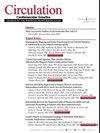Lamin A/C Cardiomyopathy: Cutting Edge to Personalized Medicine.
引用次数: 10
Abstract
Dilated cardiomyopathy (DCM) has a prevalence currently estimated as high as 1:250/1:500 and affects mostly young working-age people.1 Despite recent advances in medical and device therapies, the prognosis of DCM has been significantly improved in last decades,2 heart failure or sudden deaths, hospitalizations, need of heart transplantation, and morbidity rates remain relatively high and unpredictable.3 Consequently, more accurate risk stratification is still a critical and unmet issue. See Article by Nishiuchi et al Genetic characterization is gaining a prominent role in personalizing DCM prognostication. In the past, the proportion of patients with genetically determined DCM has been substantially underestimated because of variable clinical presentation, incomplete disease penetrance, and the lack of specific phenotypes. However, recent series using genetic screening suggest that ≤40% of DCM is genetically determined.4 To date, >50 genes have been implicated in DCM.5 Nevertheless, genotype–phenotype interactions still represent a challenge for translational research and cardiology. In fact, genotype information often does not have a known corresponding specific clinical phenotype. In particular, the clinical management of relatives carrying likely or possibly pathogenic mutations without overt phenotype remains currently uncertain in the specific setting of DCM. In this field, LMNA had always represented the more investigated gene with several prospective and retrospective studies.6–8 Because of the association with a relatively high incidence of sudden cardiac death or major ventricular arrhythmias, even before development of systolic left ventricular dysfunction, LMNA mutations represent the only genetic background in DCM that change clinical choices such as the implantable cardioverter defibrillator therapy in …纤层蛋白A/C心肌病:个性化医疗的前沿。
本文章由计算机程序翻译,如有差异,请以英文原文为准。
求助全文
约1分钟内获得全文
求助全文
来源期刊

Circulation: Cardiovascular Genetics
CARDIAC & CARDIOVASCULAR SYSTEMS-GENETICS & HEREDITY
自引率
0.00%
发文量
0
审稿时长
6-12 weeks
期刊介绍:
Circulation: Genomic and Precision Medicine considers all types of original research articles, including studies conducted in human subjects, laboratory animals, in vitro, and in silico. Articles may include investigations of: clinical genetics as applied to the diagnosis and management of monogenic or oligogenic cardiovascular disorders; the molecular basis of complex cardiovascular disorders, including genome-wide association studies, exome and genome sequencing-based association studies, coding variant association studies, genetic linkage studies, epigenomics, transcriptomics, proteomics, metabolomics, and metagenomics; integration of electronic health record data or patient-generated data with any of the aforementioned approaches, including phenome-wide association studies, or with environmental or lifestyle factors; pharmacogenomics; regulation of gene expression; gene therapy and therapeutic genomic editing; systems biology approaches to the diagnosis and management of cardiovascular disorders; novel methods to perform any of the aforementioned studies; and novel applications of precision medicine. Above all, we seek studies with relevance to human cardiovascular biology and disease.
 求助内容:
求助内容: 应助结果提醒方式:
应助结果提醒方式:


